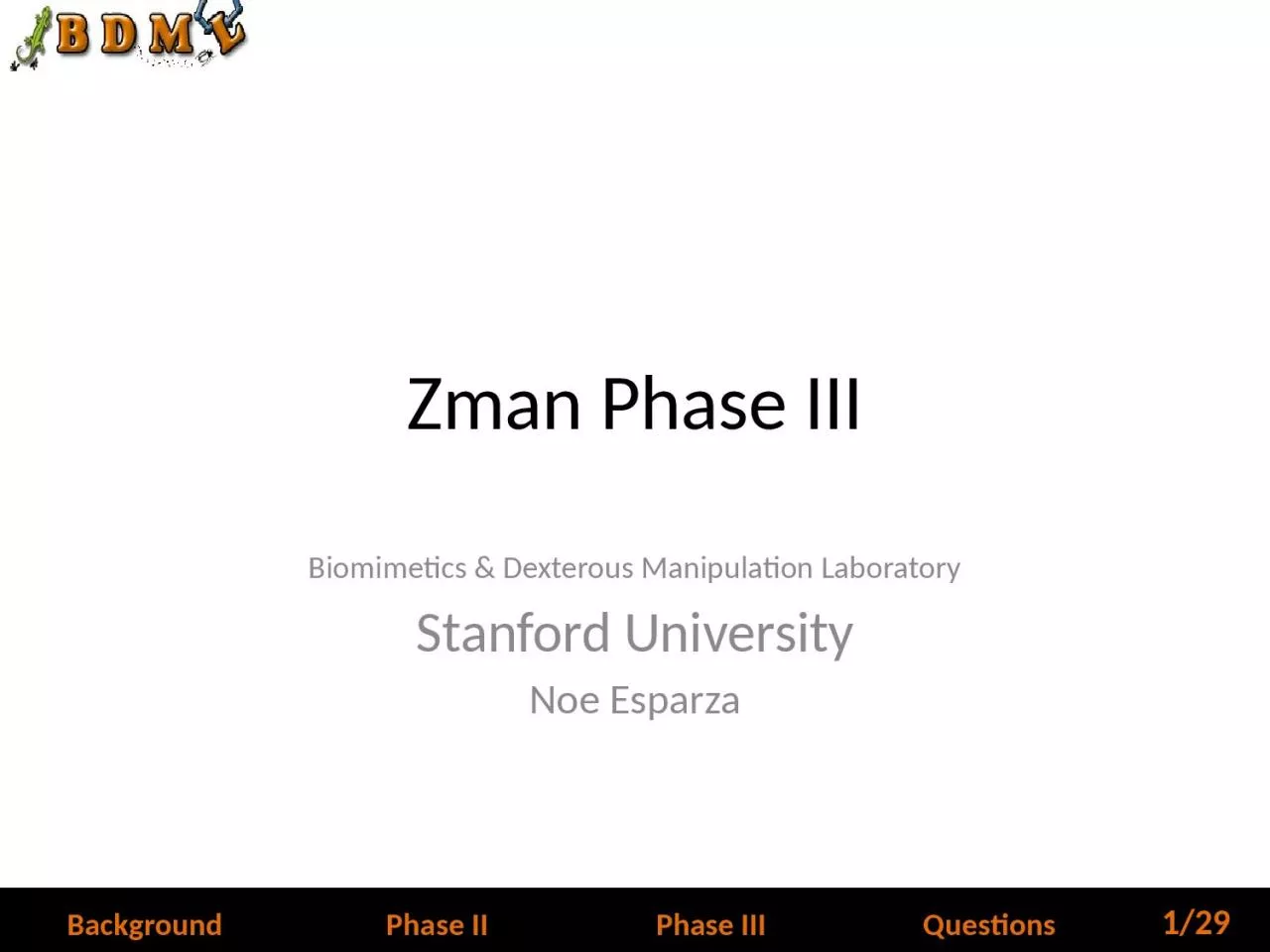

amp Dexterous Manipulation Laboratory Stanford University Noe Esparza Climbing Adhesive DirectionalControllable Minimal Preload to Engage Dry Adhesion Robust Hierarchical Structure Toe ID: 929920
Download Presentation The PPT/PDF document "Zman Phase III Biomimetics" is the property of its rightful owner. Permission is granted to download and print the materials on this web site for personal, non-commercial use only, and to display it on your personal computer provided you do not modify the materials and that you retain all copyright notices contained in the materials. By downloading content from our website, you accept the terms of this agreement.
Slide1
Zman Phase III
Biomimetics
& Dexterous Manipulation Laboratory
Stanford University
Noe
Esparza
Slide2Climbing Adhesive
Directional/Controllable
Minimal Preload to Engage
Dry AdhesionRobustHierarchical Structure
Toe
Lamellae
Setae
Spatulae
10cm
1cm
100um
1um
Slide3Single-Layer Structure
Slide4Sliding Failure
Force
Time
0
Single Event Failure
Force
Time
0
Directional Limit Surface
Limit surface points defined by individual failures
2 modes of contact failure
Single event failure
Sliding failure
Max Power Method*
*
S.
Goyal
, A.
Ruina
, and J. Papadopoulos
Slide5Directional Limit Surface
Adhesion in Climbing
Directional
ReusableDynamic Adhesion (safer failure mechanism)
Slide6Dynamic Adhesion
O – 1: Preload
1 – 2: Load
2 – 3: Drag/Sliding3 – 4: Pull OffAdhesion in ClimbingDirectionalReusable
Dynamic Adhesion (safer failure mechanism)
Slide7Dynamic Adhesion Experimental Data Video
Slide8Longevity
*1cm drag length
Adhesion in Climbing
DirectionalReusable
Dynamic Adhesion (safer failure mechanism)
Slide9Where the Single-Layer Approach Fails
Scaling
Rough Surfaces
Hierarchy III50 μm Wedges
Slide10Phase II
Incorporation of hierarchy –
pic
Improved scalingImproved rough surfaceRefined hierarchy
Slide11Hierarchical Capabilities
Phase I
Phase II
Varnished
wood and metal
Plastics
Wood, drywall, cardboard
Glass
Slide12Rough Surfaces
Hierarchy III
50
μm Wedges
Slide13Scaling
Hierarchy II
Hierarchy III
Hang Test
Hierarchy II50
μm Wedges
Experimental
Testbed
Slide14Large Patch Demo Video
Slide15Refining Hierarchy
Hier
I
Hier IIHier III
Slide16Hierarchical Development
Hier
I
Hier IIHier III
Slide17Phase III
Build finite element models to inform suspension design
Generate
vDw simulations to optimize terminal featureRougher surfaces through expanded hierarchyExplore wet adhesionImproving performance
Slide18Decoupling Hierarchy Design
Hierarchy behavior occurs at multiple scales
Suspension scale (mm)
Commercial products are viablePreload path onlyTerminal features scale (μm)Custom FE code~2mm~40μm
Slide19Analyzing Suspension Design
Hier
I
Hier IIHier IIIModeled in Ansys Preload path Large deformation
Isotropic material prop. Approximated terminal features
Periodic boundary conditions
Slide20Analyzing Suspension Design
Hier
I
Hier
II
Hier III
Smin0
5082744
Smax2196220957
7635
Slide21Suspension Modeling Outcomes
Optimize stress distribution
Judge ability to conform to rough surfaces
Slide22Custom Finite Element Code for van
der
Waals Simulation
van der Waals ImplementationInfinite half-spacez
Where,
A =
Hamaker constantσ = from Lennard-Jones
potentialz = distance from half-space
Slide23van der
Waals
Simulation with Quasi-Continuum Implementation
yExplanation of QCHopes of understanding stress profile
Slide24Wet adhesion
Beetle example
Setae structures
High shear capabilitiesIncreased adhesion via introduction of liquidTree frog exampleAdhesion in humid environmentsLow slipLiquid retention
Slide25Wet Adhesion in Beetles
100um
10 um
Hemisphaerota Cyanea Beetle
1mm
Oil-based liquid in combination with setaeSimilar composition to motor oil
Eisner, T and Aneshansley
, D. “Defense by Foot Adhesion in a Beetle. PNAS. Vol 97, No. 12. June 6, 2000: pg 6568-6573.
Slide26Tree Frog Toe Pad Structure
Scholz
et al. “
Ultrastructure and physical properties of an adhesive surface, the toe pad epithelium of the tree frog, Litoria caerulea White”. J. of Exp. Bio. Vol 212. 2009: pg 155-162.
Slide27Nano
-scale projections redirect excess fluid away from surface, and conform to rough substrate surfaces
Dimples on surface of projections may yield suction effects
10% of toe surface is <1nm away from substrate Federle, W. “Wet but Not Slippery: Boundary Friction in Tree Frog Adhesive Toe Pads”. J. of the Royal Soc. Int. 2006 Oct 22; 3(10): 689-697. Toe Pad
Environment
Dimples
Tree Frog
L
ow
Slip
M
echanism
Slide28Tree Frog Adhesion Mechanism
Frogs use watery mucus with low viscosity
Fast flow is essential
Crack propagation arrested by channelsToe PadSubstrateMucusPersson, BJ. “Wet Adhesion with Application to Tree Frog Adhesive Toe Pads and Tires”. Journal of Physics. 2007, Vol. 19: 1-16.
Slide29What Determines Capillary Force?
On a spherical particle due to a flat plane:
Pagano
, C., Ferraris, E., Malosio, M., Fassi, I., “Micro-handling of parts in presence of adhesive forces”, CIRP Seminar on Micro and Nano
Technology 2003, Copenhagen, November 13–14 2003: pg. 81–84.
Where ∆p is the Laplace Pressure difference across the meniscus:
*Assuming static conditions and no gravity
Slide30Concave Tip Feature
with water
Slide31Questions
Slide32Extra Slides
Slide33What liquid do tree frogs use?
Frogs use watery mucous
Fast flow is essential
Toe PadPersson, BJ. “Wet Adhesion with Application to Tree Frog Adhesive Toe Pads and Tires”. Journal of Physics. 2007, Vol. 19: 1-16.
Slide34Hier Fabrication